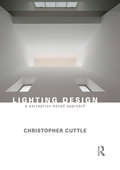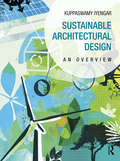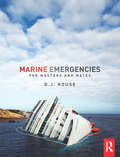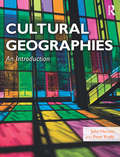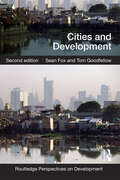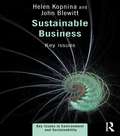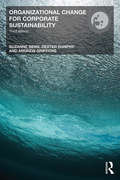- Table View
- List View
Introduction to Rural Planning: Economies, Communities and Landscapes
by Nick Gallent Iqbal Hamiduddin Meri Juntti Sue Kidd Dave ShawIntroduction to Rural Planning: Economies, Communities and Landscapes provides a critical analysis of the key challenges facing rural places and the ways that public policy and community action shape rural spaces.? The second edition provides an examination of the composite nature of ‘rural planning’, which combines land-use and spatial planning elements with community action, countryside management and the projects and programmes of national and supra-national agencies and organisations. It also offers a broad analysis of entrepreneurial social action as a shaper of rural outcomes, with particular coverage of the localism agenda and Neighbourhood Planning in England. With a focus on accessibility and rural transport provision, this book examines the governance arrangements needed to deliver integrated solutions spanning urban and rural places. Through an examination of the ecosystem approach to environmental planning, it links the procurement of ecosystem services to the global challenges of habitat degradation and loss, climate change and resource scarcity and management. A valuable resource for students of planning, rural development and rural geography, Introduction to Rural Planning aims to make sense of current rural challenges and planning approaches, evaluating the currency of the ‘rural’ label in the context of global urbanisation, arguing that rural spaces are relational spaces characterised by critical production and consumption tensions.?
Lighting Design: A Perception-Based Approach
by Christopher CuttleBy reading this book, you will develop the skills to perceive a space and its contents in light, and be able to devise a layout of luminaires that will provide that lit appearance. Written by renowned lighting expert Christopher (Kit) Cuttle, the book: explains the difference between vision and perception, which is the distinction between providing lighting to make things visible, and providing it to influence the appearance of everything that is visible; demonstrates how lighting patterns generated by three-dimensional objects interacting with directional lighting are strongly influential upon how the visual perception process enables us to recognize object attributes, such as lightness, colourfulness, texture and gloss; reveals how a designer who understands the role of these lighting patterns in the perceptual process may employ them either to reveal, or to subdue, or to enhance the appearance of selected object attributes by creating appropriate spatial distributions of light; carefully explains calculational techniques and provides easy-to-use spreadsheets, so that layouts of lamps and luminaires are derived that can be relied upon to achieve the required illumination distributions. Practical lighting design involves devising three-dimensional light fields that create luminous hierarchies related to the visual significance of each element within a scene. By providing you with everything you need to develop a design concept - from the understanding of how lighting influences human perceptions of surroundings, through to engineering efficient and effective lighting solutions – Kit Cuttle instills in his readers a new-found confidence in lighting design.
Sustainable Architectural Design: An Overview
by Kuppaswamy IyengarThis book is a guide to a sustainable design process that moves from theory, to site and energy use, to building systems, and finally to evaluation and case studies, so you can integrate design and technology for effective sustainable building. Kuppaswamy Iyengar shows you how to get it right the first time, use free energy systems, and utilise technologies that minimize fossil fuel use. Each chapter has a sustainable design overview, technical details and strategies marked by clear sections, a summary, and further resources. Heavily illustrated with charts, tables, drawings, photographs, and case studies, the book shows technologies and concepts integrated into cohesive project types, from small and large office spaces to single and multiuse residences, hospitals, schools, restaurants, and warehouses to demonstrate implementing your designs to meet clients' needs now and for the future. Includes an overview of alternate assessment and evaluation systems such as BREEAM, CASBEE, GBTool, Green Globes alongside LEED, ECOTECT, energy 10, HEED and eQuest simulation programs. The guide reveals the importance of the building envelope—walls, superstructure, insulation, windows, floors, roofs, and building materials—on the environmental impact of a building, and has a section on site systems examining site selection, landscape design, thermal impact, and building placement.
Sustainable Architectural Design: An Overview
by Kuppaswamy IyengarThis book is a guide to a sustainable design process that moves from theory, to site and energy use, to building systems, and finally to evaluation and case studies, so you can integrate design and technology for effective sustainable building. Kuppaswamy Iyengar shows you how to get it right the first time, use free energy systems, and utilise technologies that minimize fossil fuel use. Each chapter has a sustainable design overview, technical details and strategies marked by clear sections, a summary, and further resources. Heavily illustrated with charts, tables, drawings, photographs, and case studies, the book shows technologies and concepts integrated into cohesive project types, from small and large office spaces to single and multiuse residences, hospitals, schools, restaurants, and warehouses to demonstrate implementing your designs to meet clients' needs now and for the future. Includes an overview of alternate assessment and evaluation systems such as BREEAM, CASBEE, GBTool, Green Globes alongside LEED, ECOTECT, energy 10, HEED and eQuest simulation programs. The guide reveals the importance of the building envelope—walls, superstructure, insulation, windows, floors, roofs, and building materials—on the environmental impact of a building, and has a section on site systems examining site selection, landscape design, thermal impact, and building placement.
Population and Development
by W.T.S. GouldThe new edition of Population and Development offers an up-to-date perspective on one of the critical issues at the heart of the problems of development for all countries, and especially those that seek to implement major economic and social change: the reflexive relationships between a country’s population and its development. How does population size, distribution, age structure and skill base affect development patterns and prospects? How has global development been affected by regional population change? Retaining the structure of the well-received first edition, the book has been substantially revised and updated. The opening chapters of the book establish the theoretical and historical basis for examining the basic reflexive relationship, with exploration of the Malthusian perspective and its critics to examine how population change affects development, and exploration of the Demographic Transition Model and its critics to examine how, why and to what extent development drives population change. These are followed by empirically rich chapters on each of the main components of population change – mortality, fertility, internal and international migration, age structures and skill base – each elaborating key ideas with detailed and contrasting case studies from all regions of the developing world. There are concluding and more integrative discussions on population policies and global population futures. Bringing together Population Studies, Development Studies and Geography, the new edition of Population and Development is a key resource for undergraduate and postgraduate students across a range of programmes with specialist modules on population change. There is a large bibliography, with major new sections identifying a wide range of online resources for further study. Each chapter contains a reading guide with discussion questions. The text is enlivened by a number of case studies from around the world, most of which are new or have been substantially revised. Written by a leading international scholar in population, the book successfully integrates cutting-edge academic research with the focus and efforts of international development agencies.
Population and Development
by W.T.S. GouldThe new edition of Population and Development offers an up-to-date perspective on one of the critical issues at the heart of the problems of development for all countries, and especially those that seek to implement major economic and social change: the reflexive relationships between a country’s population and its development. How does population size, distribution, age structure and skill base affect development patterns and prospects? How has global development been affected by regional population change? Retaining the structure of the well-received first edition, the book has been substantially revised and updated. The opening chapters of the book establish the theoretical and historical basis for examining the basic reflexive relationship, with exploration of the Malthusian perspective and its critics to examine how population change affects development, and exploration of the Demographic Transition Model and its critics to examine how, why and to what extent development drives population change. These are followed by empirically rich chapters on each of the main components of population change – mortality, fertility, internal and international migration, age structures and skill base – each elaborating key ideas with detailed and contrasting case studies from all regions of the developing world. There are concluding and more integrative discussions on population policies and global population futures. Bringing together Population Studies, Development Studies and Geography, the new edition of Population and Development is a key resource for undergraduate and postgraduate students across a range of programmes with specialist modules on population change. There is a large bibliography, with major new sections identifying a wide range of online resources for further study. Each chapter contains a reading guide with discussion questions. The text is enlivened by a number of case studies from around the world, most of which are new or have been substantially revised. Written by a leading international scholar in population, the book successfully integrates cutting-edge academic research with the focus and efforts of international development agencies.
Renewable Energy Resources
by John Twidell Tony WeirRenewable Energy Resources is a numerate and quantitative text covering the full range of renewable energy technologies and their implementation worldwide. Energy supplies from renewables (such as from biofuels, solar heat, photovoltaics, wind, hydro, wave, tidal, geothermal, and ocean-thermal) are essential components of every nation’s energy strategy, not least because of concerns for the local and global environment, for energy security and for sustainability. Thus in the years between the first and this third edition, most renewable energy technologies have grown from fledgling impact to significant importance because they make good sense, good policy and good business. This Third Edition is extensively updated in light of these developments, while maintaining the book’s emphasis on fundamentals, complemented by analysis of applications. Renewable energy helps secure national resources, mitigates pollution and climate change, and provides cost effective services. These benefits are analysed and illustrated with case studies and worked examples. The book recognises the importance of cost effectiveness and efficiency of end-use. Each chapter begins with fundamental scientific theory, and then considers applications, environmental impact and socio-economic aspects before concluding with Quick Questions for self-revision and Set Problems. The book includes Reviews of basic theory underlying renewable energy technologies, such as electrical power, fluid dynamics, heat transfer and solid-state physics. Common symbols and cross-referencing apply throughout; essential data are tabulated in appendices. An associated eResource provides supplementary material on particular topics, plus a solutions guide to Set Problems. Renewable Energy Resources supports multi-disciplinary master degrees in science and engineering, and specialist modules in first degrees. Practising scientists and engineers who have not had a comprehensive training in renewable energy will find it a useful introductory text and a reference book.
Renewable Energy Resources
by John Twidell Tony WeirRenewable Energy Resources is a numerate and quantitative text covering the full range of renewable energy technologies and their implementation worldwide. Energy supplies from renewables (such as from biofuels, solar heat, photovoltaics, wind, hydro, wave, tidal, geothermal, and ocean-thermal) are essential components of every nation’s energy strategy, not least because of concerns for the local and global environment, for energy security and for sustainability. Thus in the years between the first and this third edition, most renewable energy technologies have grown from fledgling impact to significant importance because they make good sense, good policy and good business. This Third Edition is extensively updated in light of these developments, while maintaining the book’s emphasis on fundamentals, complemented by analysis of applications. Renewable energy helps secure national resources, mitigates pollution and climate change, and provides cost effective services. These benefits are analysed and illustrated with case studies and worked examples. The book recognises the importance of cost effectiveness and efficiency of end-use. Each chapter begins with fundamental scientific theory, and then considers applications, environmental impact and socio-economic aspects before concluding with Quick Questions for self-revision and Set Problems. The book includes Reviews of basic theory underlying renewable energy technologies, such as electrical power, fluid dynamics, heat transfer and solid-state physics. Common symbols and cross-referencing apply throughout; essential data are tabulated in appendices. An associated eResource provides supplementary material on particular topics, plus a solutions guide to Set Problems. Renewable Energy Resources supports multi-disciplinary master degrees in science and engineering, and specialist modules in first degrees. Practising scientists and engineers who have not had a comprehensive training in renewable energy will find it a useful introductory text and a reference book.
Local and Regional Development
by Andy Pike Andrés Rodriguez-Pose John TomaneyActors and institutions in localities and regions across the world are seeking prosperity and well-being amidst tumultuous and disruptive shifts and transitions generated by: an increasingly globalised, knowledge-intensive capitalism; global financial instability, volatility and crisis; concerns about economic, social and ecological sustainability, climate change and resource shortages; new multi-actor and multi-level systems of government and governance and a re-ordering of the international political economy; state austerity and retrenchment; and, new and reformed approaches to intervention, policy and institutions for local and regional development. Local and Regional Development provides an accessible, critical and integrated examination of local and regional development theory, institutions and policy in this changing context. Amidst its rising importance, the book addresses the fundamental issues of ‘what kind of local and regional development and for whom?’, its purposes, principles and values, frameworks of understanding, approaches and interventions, and integrated approaches to local and regional development throughout the world. The approach provides a theoretically informed, critical analysis of contemporary local and regional development in an international and multi-disciplinary context, grounded in concrete empirical analysis from experiences in the global North and South. It concludes by identifying what might constitute holistic, inclusive, progressive and sustainable local and regional development, and reflecting upon its limits and political renewal.
Ecomedia: Key Issues (Key Issues in Environment and Sustainability)
by Sean Cubitt Stephen Rust Salma MonaniEcomedia: Key Issues is a comprehensive textbook introducing the burgeoning field of ecomedia studies to provide an overview of the interface between environmental issues and the media globally. Linking the world of media production, distribution, and consumption to environmental understandings, the book addresses ecological meanings encoded in media texts, the environmental impacts of media production, and the relationships between media and cultural perceptions of the environment.Each chapter introduces a distinct type of media, addressing it in a theoretical overview before engaging with specific case studies. In this way, the book provides an accessible introduction to each form of media as well as a sophisticated analysis of relevant cases. The book includes contributions from a combination of new voices and well-established media scholars from across the globe who examine the basic concepts and key issues of ecomedia studies. The concepts of "frames," "flow", and "convergence" structure a dynamic collection divided into three parts. The first part addresses traditional visual texts, such as comics, photography, and film. The second part of the book addresses traditional broadcast media, such as radio, and television, and the third part looks at new media, such as advertising, video games, the internet, and digital renderings of scientific data. In its breadth and scope, Ecomedia: Key Issues presents a unique survey of rich scholarship at the confluence of Media Studies and Environmental Studies. The book is written in an engaging and accessible style, with each chapter including case studies, discussion questions and suggestions for further reading.
Marine Emergencies: For Masters and Mates
by David HouseAn influential guide to maritime emergencies and the current strategies that can be employed to cope with the immediate after effects and ramifications of disaster at sea. Many mariners will at some point in their maritime careers become involved in one sort of emergency or another, while in port or at sea, whether it is a fire on board, a collision with another vessel or an engine failure threatening a lee shore. Actions to take in such incidents can be the difference between survival and catastrophic loss. This text provides a direct insight into some of the latest incidents and includes: case studies from emergencies worldwide checklists and suggestions for emergency situations. everything from fire and collision right through to the legal implications of salvage. David House has now written and published eighteen marine titles, many of which are in multiple editions. After commencing his seagoing career in 1962, he was initially engaged on general cargo vessels. He later experienced worldwide trade with passenger, container, Ro-Ro, reefer ships and bulk cargoes. He left the sea in 1978 with a Master Mariner's qualification and commenced teaching at the Fleetwood Nautical College. He retired in 2012 after thirty three years of teaching in nautical education. He continues to write and research maritime aspects for future works.
Marine Emergencies: For Masters and Mates
by David HouseAn influential guide to maritime emergencies and the current strategies that can be employed to cope with the immediate after effects and ramifications of disaster at sea. Many mariners will at some point in their maritime careers become involved in one sort of emergency or another, while in port or at sea, whether it is a fire on board, a collision with another vessel or an engine failure threatening a lee shore. Actions to take in such incidents can be the difference between survival and catastrophic loss. This text provides a direct insight into some of the latest incidents and includes: case studies from emergencies worldwide checklists and suggestions for emergency situations. everything from fire and collision right through to the legal implications of salvage. David House has now written and published eighteen marine titles, many of which are in multiple editions. After commencing his seagoing career in 1962, he was initially engaged on general cargo vessels. He later experienced worldwide trade with passenger, container, Ro-Ro, reefer ships and bulk cargoes. He left the sea in 1978 with a Master Mariner's qualification and commenced teaching at the Fleetwood Nautical College. He retired in 2012 after thirty three years of teaching in nautical education. He continues to write and research maritime aspects for future works.
Interpreting Site: Studies in Perception, Representation, and Design
by Genevieve S. BaudoinInterpreting Site explains the basic methods architects use to translate what you perceive to represent the complex conditions that physically and mentally "construe" a site, helping to shape the ultimate design. Within each of the four themes---defining site, experiencing site, spatializing site, and systematizing site--- theoretical, conceptual, and analytic methods and representational tools are introduced to give you a foundation to develop your own approach to the conditions of a site. Author Genevieve S. Baudoin examines longstanding representation methods in relation to emerging and experimental methods, offering an idiosyncratic and provocative look at different approaches. Four highly illustrated full colour case studies of key contemporary projects in Spain, the United States, the United Kingdom, and Norway demonstrate how architects have used conditions discovered on a site in their final design.
Cultural Geographies: An Introduction
by John Horton Peter KraftlCultural geography is a major, vibrant subdiscipline of human geography. Cultural geographers have done some of the most important, exciting and thought-provokingly zesty work in human geography over the last half-century. This book exists to provide an introduction to the remarkably diverse, controversial, and sometimes-infuriating work of cultural geographers. The book outlines how cultural geography in its various forms provides a rich body of research about cultural practices and politics in diverse contexts. Cultural geography offers a major resource for exploring the importance of cultural materials, media, texts and representations in particular contexts and is one of the most theoretically adventurous subdisciplines within human geography, engaging with many important lines of social and cultural theory. The book has been designed to provide an accessible, wide-ranging and thought-provoking introduction for students studying cultural geography, or specific topics within this subdiscipline. Through a wide range of case studies and learning activities, it provides an engaging introduction to cultural geography.
Cultural Geographies: An Introduction
by John Horton Peter KraftlCultural geography is a major, vibrant subdiscipline of human geography. Cultural geographers have done some of the most important, exciting and thought-provokingly zesty work in human geography over the last half-century. This book exists to provide an introduction to the remarkably diverse, controversial, and sometimes-infuriating work of cultural geographers. The book outlines how cultural geography in its various forms provides a rich body of research about cultural practices and politics in diverse contexts. Cultural geography offers a major resource for exploring the importance of cultural materials, media, texts and representations in particular contexts and is one of the most theoretically adventurous subdisciplines within human geography, engaging with many important lines of social and cultural theory. The book has been designed to provide an accessible, wide-ranging and thought-provoking introduction for students studying cultural geography, or specific topics within this subdiscipline. Through a wide range of case studies and learning activities, it provides an engaging introduction to cultural geography.
Reconstructing Quaternary Environments
by J. John Lowe Michael J.C WalkerThis third edition of Reconstructing Quaternary Environments has been completely revised and updated to provide a new account of the history and scale of environmental changes during the Quaternary. The evidence is extremely diverse ranging from landforms and sediments to fossil assemblages and geochemical data, and includes new data from terrestrial, marine and ice-core records. Dating methods are described and evaluated, while the principles and practices of Quaternary stratigraphy are also discussed. The volume concludes with a new chapter which considers some of the key questions about the nature, causes and consequences of global climatic and environmental change over a range of temporal scales. This synthesis builds on the methods and approaches described earlier in the book to show how a number of exciting ideas that have emerged over the last two decades are providing new insights into the operation of the global earth-ocean-atmosphere system, and are now central to many areas of contemporary Quaternary research. This comprehensive and dynamic textbook is richly illustrated throughout with full-colour figures and photographs. The book will be of interest to undergraduates, postgraduates and professionals in Earth Science, Environmental Science, Physical Geography, Geology, Botany, Zoology, Ecology, Archaeology and Anthropology
Reconstructing Quaternary Environments
by J. John Lowe Michael J.C WalkerThis third edition of Reconstructing Quaternary Environments has been completely revised and updated to provide a new account of the history and scale of environmental changes during the Quaternary. The evidence is extremely diverse ranging from landforms and sediments to fossil assemblages and geochemical data, and includes new data from terrestrial, marine and ice-core records. Dating methods are described and evaluated, while the principles and practices of Quaternary stratigraphy are also discussed. The volume concludes with a new chapter which considers some of the key questions about the nature, causes and consequences of global climatic and environmental change over a range of temporal scales. This synthesis builds on the methods and approaches described earlier in the book to show how a number of exciting ideas that have emerged over the last two decades are providing new insights into the operation of the global earth-ocean-atmosphere system, and are now central to many areas of contemporary Quaternary research. This comprehensive and dynamic textbook is richly illustrated throughout with full-colour figures and photographs. The book will be of interest to undergraduates, postgraduates and professionals in Earth Science, Environmental Science, Physical Geography, Geology, Botany, Zoology, Ecology, Archaeology and Anthropology
Eco-Urbanity: Towards Well-Mannered Built Environments
by Darko RadovicThere is need for change in our currently unsustainable cities. Carefully outlining paths towards better, sustainable ways of urban living, this book proposes a radical change in the ways we conceive and live our urban environments. Bringing together diverse cultural and disciplinary views on urban sustainability, eighteen leading academics and practitioners in sustainable architecture and urbanism explore global concerns of sustainability and urbanity. This broad range of issues are clearly articulated and linked to concrete places and projects, merging research and cutting-edge design investigations to promote environmentally and culturally sensitive urban futures.
Eco-Urbanity: Towards Well-Mannered Built Environments
by Darko RadovicThere is need for change in our currently unsustainable cities. Carefully outlining paths towards better, sustainable ways of urban living, this book proposes a radical change in the ways we conceive and live our urban environments. Bringing together diverse cultural and disciplinary views on urban sustainability, eighteen leading academics and practitioners in sustainable architecture and urbanism explore global concerns of sustainability and urbanity. This broad range of issues are clearly articulated and linked to concrete places and projects, merging research and cutting-edge design investigations to promote environmentally and culturally sensitive urban futures.
Cities and Development (Routledge Perspectives on Development)
by Sean Fox Tom GoodfellowFor the first time in human history more people now live and towns and cities than in rural areas. In the wealthier countries of the world, the transition from predominantly rural to urban habitation is more or less complete. But in many parts of Africa, Asia and Latin America, urban populations are expanding rapidly. Current UN projections indicate that virtually all population growth in the world over the next 30 years will be absorbed by towns and cities in developing countries. These simple demographic facts have profound implications for those concerned with understanding and addressing the pressing global development challenges of reducing poverty, promoting economic growth, improving human security and confronting environmental change. This revised and expanded second edition of Cities and Development explores the dynamic relationship between urbanism and development from a global perspective. The book surveys a wide range of topics, including: the historical origins of world urbanization; the role cities play in the process of economic development; the nature of urban poverty and the challenge of promoting sustainable livelihoods; the complexities of managing urban land, housing, infrastructure and urban services; and the spectres of endemic crime, conflict and violence in urban areas. This updated volume also contains two entirely new chapters: one that examines the links between urbanisation and environmental change, and a second that focuses on urban governance and politics. Adopting a multidisciplinary perspective, the book critically engages with debates in urban studies, geography and international development studies. Each chapter includes supplements in the form of case studies, chapter summaries, questions for discussion and suggested further readings. The book is targeted at upper-level undergraduate and graduate students interested in geography, urban studies and international development studies, as well as policy makers, urban planners and development practitioners.
Sustainable Business: Key Issues
by Helen Kopnina John BlewittSustainable Business: Key Issues is the first comprehensive introductory-level textbook to address the interface between environmental challenges and business solutions to provide an overview of the basic concepts of sustainability, sustainable business, and business ethics. The book introduces students to the background and key issues of sustainability and suggests ways in which these concepts can be applied in business practice. Though the book takes a business perspective, it is interdisciplinary in its nature and draws on knowledge from socio-economic, political, and environmental studies, thereby providing a practical and critical understanding of sustainability in the changing paradigm of global business. It goes beyond the conventional theories of sustainability and addresses critical issues concerned with population, consumption and economic growth. It discusses realistic ways forward, in particular the Circular Economy and Cradle to Cradle frameworks. The book is both a theoretical and practical study guide for undergraduate and postgraduate international students of broad areas of sustainability, teaching ways to recognize opportunities for innovation and entrepreneurship at the intersection of environmental, economic, ethical, and social systems. It takes a strategic approach in applying the power of business methods and policy to address issues of global importance such as climate change, poverty, ecosystem degradation and human rights. This textbook is essential reading for students of business, management and sustainability courses. It is written in an engaging and accessible style, with each chapter including case studies, discussion questions, end of chapter summaries and suggestions for further reading.
Sustainable Business: Key Issues
by Helen Kopnina John BlewittSustainable Business: Key Issues is the first comprehensive introductory-level textbook to address the interface between environmental challenges and business solutions to provide an overview of the basic concepts of sustainability, sustainable business, and business ethics. The book introduces students to the background and key issues of sustainability and suggests ways in which these concepts can be applied in business practice. Though the book takes a business perspective, it is interdisciplinary in its nature and draws on knowledge from socio-economic, political, and environmental studies, thereby providing a practical and critical understanding of sustainability in the changing paradigm of global business. It goes beyond the conventional theories of sustainability and addresses critical issues concerned with population, consumption and economic growth. It discusses realistic ways forward, in particular the Circular Economy and Cradle to Cradle frameworks. The book is both a theoretical and practical study guide for undergraduate and postgraduate international students of broad areas of sustainability, teaching ways to recognize opportunities for innovation and entrepreneurship at the intersection of environmental, economic, ethical, and social systems. It takes a strategic approach in applying the power of business methods and policy to address issues of global importance such as climate change, poverty, ecosystem degradation and human rights. This textbook is essential reading for students of business, management and sustainability courses. It is written in an engaging and accessible style, with each chapter including case studies, discussion questions, end of chapter summaries and suggestions for further reading.
Design-Tech: Building Science for Architects
by Jason Alread Thomas Leslie Robert WhiteheadDesign-Tech is an indispensable, holistic approach to architectural technology that shows you in hundreds of drawings and tables the why as well as the how of building science, providing you with a comprehensive overview. In this expanded edition, measurements and examples are listed in both metric and imperial units to reflect the global reality of architectural practice. The authors also address digital fabrication, construction documentation, ultra-high-rise structures, and zoning codes. And there's more in-depth coverage of structural design and greater emphasis on environmental forces. Numerous case studies demonstrate real-world design implications for each topic, so that you can integrate technical material with design sensibilities. Short chapters explain each topic from first principles in easy-to-reference formats, focusing on what you need to know both at the drawing board and in future discussions with engineers, contractors, and consultants. This new edition incorporates material from continuing curricular experimentation in the SCI-TECH sequence at Iowa State University, which has been recognized with awards and funding from the American Institute of Architects, the U.S. Green Building Council, and the National Council of Architectural Registration Boards.
Design-Tech: Building Science for Architects
by Jason Alread Thomas Leslie Robert WhiteheadDesign-Tech is an indispensable, holistic approach to architectural technology that shows you in hundreds of drawings and tables the why as well as the how of building science, providing you with a comprehensive overview. In this expanded edition, measurements and examples are listed in both metric and imperial units to reflect the global reality of architectural practice. The authors also address digital fabrication, construction documentation, ultra-high-rise structures, and zoning codes. And there's more in-depth coverage of structural design and greater emphasis on environmental forces. Numerous case studies demonstrate real-world design implications for each topic, so that you can integrate technical material with design sensibilities. Short chapters explain each topic from first principles in easy-to-reference formats, focusing on what you need to know both at the drawing board and in future discussions with engineers, contractors, and consultants. This new edition incorporates material from continuing curricular experimentation in the SCI-TECH sequence at Iowa State University, which has been recognized with awards and funding from the American Institute of Architects, the U.S. Green Building Council, and the National Council of Architectural Registration Boards.
Organizational Change for Corporate Sustainability
by Suzanne Benn Dexter Dunphy Andrew GriffithsSince this classic book was first published in 2003, sustainability has increasingly become mainstream business for leading corporations, whilst the topic itself has also been a hotly debated political issue across the globe. The sustainability phase models originally discussed in the book have become more relevant with ever more examples of organizations at later stages in the development of corporate sustainability. Bringing together global issues of ecological sustainability, strategic human resource management, organizational change, corporate social responsibility, leadership and community renewal, this new edition of the book further develops its unified approach to corporate sustainability and its plan of action to bring about corporate change. It integrates new research and brings illustrative case studies up to date to reflect how new approaches affect change and leadership. For the first time, a new positive model of a future sustainable world is included - strengthened by references to the global financial crisis, burgeoning world population numbers and the rise of China. With new case studies including BP's Gulf oil spill and Tokyo Electric Company's nuclear reactor disaster, this new edition will again be core reading for students and researchers of sustainability and business, organizational change and corporate social responsibility.

